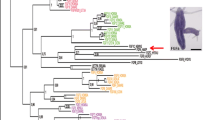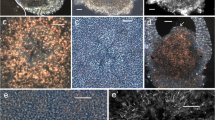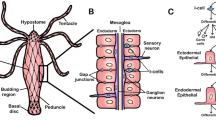Abstract
It has been shown that hydra, consisting almost exclusively of epithelial cells, have normal morphogenetic properties. This means that they are able to reproduce asexually by budding and to regenerate head or foot with conservation of the original polarity. Such hydra have no interstitial cells and they lack nerves and nematocytes as differentiation products of the interstitial stem cell. Consequently, they are unable to catch or ingest food and would not survive in nature. However, stocks can be maintained in the laboratory, if food is injected into the gastric cavity1–3. The fact that nerve-free hydra would grow and regenerate normally raised some doubts as to the role of the nervous system in the control of differentiation and development in hydra. In particular, the significance of morphogenetic substances, such as the head activator4, which is normally produced by nerve cells5, seemed to need reassessment6. We now show that epithelial cells in hydra have the potential to produce head activator and other morphogenetic factors, but that this property is repressed in the presence of nerves.
Similar content being viewed by others
References
Marcum, B. A., Campbell, R. D. & Romero, J. Science 197, 771–773 (1977).
Marcum, B. A. & Campbell, R. D. J. Cell Sci. 29, 17–33 (1978).
Sugiyama, T. & Fujisawa, T. J. Cell Sci. 29, 35–52 (1978).
Schaller, H. C. J. Embryol. exp. Morph. 29, 27–38 (1973).
Schaller, H. C. & Gierer, A. J. Embryol. exp. Morph. 29, 39–52 (1973).
Slack, J. Nature 274, 313 (1978).
Schaller, H. C., Grimmelikhuijzen, C. J. P., Schmidt, T. & Bode, H. Wilhelm Roux Arch. EntwMech. Org. (in the press).
Campbell, R. D. J. Cell Sci. 21, 1–13 (1976).
Campbell, R. D., Josephson, R. K. & Schwab, W. E. Nature 262, 388–390 (1976).
Schaller, H. C., Schmidt, T. & Grimmelikhuijzen, C. J. P. Wilhelm Roux Arch. EntwMech. Org. 186, 139–149 (1979).
Trenkner, E., Flick, K., Hansmann, G., Bode, H. & Bode, P. J. exp. Zool. 185, 317–325 (1973).
Grimmelikhuijzen, C. J. P. Cell Differentiation 8, 267–273 (1979).
Author information
Authors and Affiliations
Rights and permissions
About this article
Cite this article
Schaller, H., Rau, T. & Bode, H. Epithelial cells in nerve-free hydra produce morphogenetic substances. Nature 283, 589–591 (1980). https://doi.org/10.1038/283589a0
Received:
Accepted:
Issue Date:
DOI: https://doi.org/10.1038/283589a0
- Springer Nature Limited
This article is cited by
-
Head activator does not qualitatively alter head morphology in regenerates ofHydra oligactis
Roux's Archives of Developmental Biology (1991)
-
The fractionation of aHydra-derived inhibitor into head and foot inhibitors may be an artefact
Wilhelm Roux's Archives of Developmental Biology (1983)





